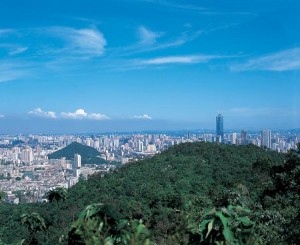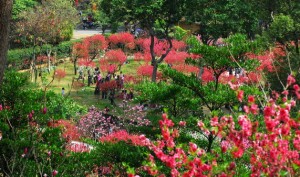Guangzhou White Cloud Mountain (Baiyun Mountain) lies in the northern outskirts of the city. The mountain range is about 7.5 kilometers (4.7 miles) north of Guangzhou and is made up of 30 odd peaks, with an area of 28 square meters (33.5 square yards). The Mountain was called White Cloud because of the forming of a white cloud over its range. Its highest peak is Moxing Peak standing in the center of the mountain, 380 meters (1,246.7 feet) above sea level. It is also called ‘the First Peak under the Southern Sky’. 
The mountain is actually a park with natural hills and waters. Really an ideal sightseeing place and summer resorts. So far six sightseeing zones have been developed: Mingzhu Tower, Moxing Ridge, Santai Ridge, Mingchun Valley, Fei’e Ridge and Luhu Lake. Apart from the existing scenes Moxing Ridge, Looking afar in the morning from White Cloud Mountain, Looking afar in the evening from White Cloud Mountain, the First Peak under the Southern Sky, Wind Soughing in the Pines on White Cloud Mountain, Village Hostel, Songtao Villa, Mingzhu Tower, Luming Restaurant and White Cloud Immortal’s House, there have been added for the past ten-odd years such scenic spots as White Cloud Cableway, Mingchun Valley – the largest birdcage in Asia, the Forest of Steles in Guangzhou, Nengren Temple, a golf course, Xinghai Garden, Yuntai Garden, the Sculpture Park and White Cloud Chute. Welcome to White Cloud Mountain when you participate in Guangzhou fair 2013 .
From ancient times, White Cloud Mountain has been one of the most famous spots of natural beauty in Guangzhou, and it’s still known as the First Spectacular Scene of the city. Every time the sun shines after the rain, and through late spring, a wreath of airy clouds circles the mountains. This is how White Cloud Mountain has won its name, and its reputation as a marvelous spectacle of nature. The fierce differentiation of rocks, and the different ways in which erosion has affected them, has caused it a crisscross network of gullies. So its relative height is now about 100 meters (109 yards). The quiet and secluded environment of the valley has made it a haven of peace from the big city.

The Moxing Ridge, originally known as the Biyun Peak, is the highest point of the Baiyun Mountain, rising 382 meters above sea level. In the ridge, different weather conditions bring about different views. On rainy days, floating clouds envelope the entire mountain, creating an intriguing view. On sunny days, visitors enjoy a panoramic view of the forest of modern buildings below. In line with local traditions, Guangzhou folks would ascend the ridge to pray for safety and fortune on the Double-Ninth Day on Chinese lunar calendar.
The mountain was already a famous scenic spot in Guangzhou in history. As one of the oldest mountains in Guangdong, it has gorgeous scenery and abundant historical relics. Among the past and present Eight Sights of Guangzhou, besides ‘Wind Soughing in the Pines on White Cloud Mountain’, there are ‘Pujian Spring’, ‘Looking afar in the evening from White Cloud Mountain’, ‘The Returned Monk at Jingtai’, ‘the Splendid Mountain of Cloud’, which depict all the beautiful scenery of White Cloud Mountain. Renowned poets and scholars of past dynasties, such as Su Shi (a famous scholar in the Northern Song Dynasty, 960 – 1127), Yang Wanli (poet in Southern Song Dyansty, 1127 – 1279), Wang Shizhen (historian in Ming Dynasty, 1368 – 1644) and others once came here and left poems and words after the visit.